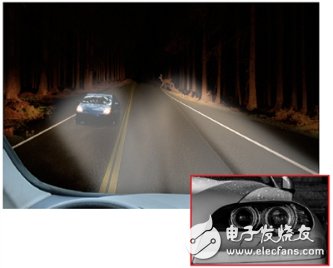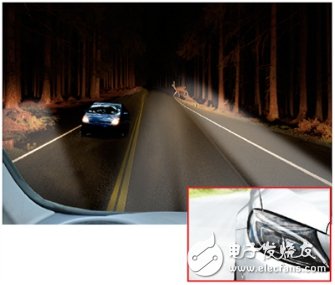In general, the headlights of a car are typically light-emitting diode (LED) headlight units that employ a switch mode regulator. These LED headlights are static, either on or off. When it is bad weather, the driver may turn on the fog light, or use the low beam when driving at night and the high beam when climbing. However, do you encounter the situation in the figure below (as shown in Figure 1)? When the car turns on the high beam, it will emit glare, and this glare will affect the line of sight, so it is quite dangerous.

Figure 1: Traditional car headlight technology
If there is an intelligent system that can detect the vehicle coming from the opposite lane and close part of the high beam in time (as shown in Figure 2), or can change the angle of the light according to the position of the vehicle on the opposite lane, is it in some sense? Has it improved road safety? In recent years, automakers around the world have continued to invest in research and development in this area, and some high-end cars have now adopted such technology. Below, let's take a look at what is in the headlights of this type.

Figure 2: Adaptive headlight illumination
The Advanced Driver Assistance System (ADAS) includes a camera that detects images around the car and provides real-time information to the car's central control system. The headlights are made up of small pixels that can be turned on and off, respectively, or adjusted for light intensity. The driver can feed back information to the ADAS to inform the headlights that different operations should be performed based on the real-time position of the opposite vehicle. This is the anti-glare function implemented in the adaptive headlights. In addition, the adaptive headlights can also rely on power to switch or adjust far and low beam lights without using the engine.
At the end of 2014, TI's TPS92661-Q1 LED Matrix Manager made it possible for headlight manufacturers to produce adaptive headlights. It can control 12 LEDs in series, just connect them all to the TPS92661-Q1. An MCU running under the Universal Asynchronous Receiver Transmitter (UART) protocol can command each LED pixel in the TPS92661-Q1 control matrix. A UART system can be connected to up to eight TPS92661-Q1 devices (three physical address pins); therefore, the maximum number of pixels available for an adaptive headlight is 96.
The TPS92661-Q1 LED Matrix Manager has 12 individual switches in parallel with the LEDs. Once connected, the LEDs can be turned on, off, or pulse width modulated (PWM) dimmed. The TPS92661-Q1 provides 10-bit PWM dimming resolution or 1024-level brightness control for each individual LED. Since all LEDs are individually connected to the device, their open-circuit condition will be protected from short-circuiting of the device switch, and its internal registers can also record faults when an open or shorted LED is detected.
A car with adaptive LED headlights not only improves road safety, but also makes the driver a safer driving experience. This is a win-win innovation.
Tinned Copper Clad Copper TCCC
Corrosion-Resistant Copper-Clad Tinned Wire,Copper-Clad Copper Tinned Wire Production,Copper-Clad Copper Tinned Wire Processing,Copper-Clad Tinned Wire
changzhou yuzisenhan electronic co.,ltd , https://www.ccs-yzsh.com